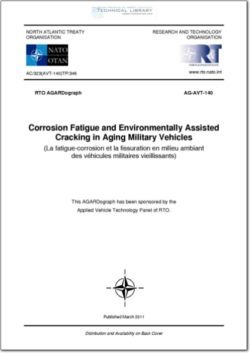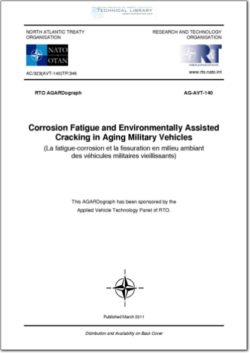AGARD-RTO-AG-AVT-140

- Version
- 356 Downloads
- 38.89 MB File Size
- 1 File Count
- April 28, 2016 Create Date
- April 28, 2016 Last Updated
Corrosion Fatigue and Environmentally Assisted Cracking in Aging Military Vehicles

Damage to metallic aircraft structures due to corrosion is a continuing problem to operators, giving rise to
high maintenance costs and loss of aircraft availability. Traditionally viewed as an economic issue, recent
work has made a strong case that corrosion is also a threat to flight safety.
There is no universal solution to the problem of corrosion and thus it must be addressed at all stages of the
equipment life cycle from initial design through careful selection of structural materials, corrosion
protection systems, joint design and assembly, in-service inspection, maintenance and finally repair and
refurbishment. In this report the Applied Vehicles Technology Panel of the NATO—RTO reviews progress
in these areas occurring over the past twenty five years and with particular emphasis on the impact of
corrosion on structural integrity and safety. Typically in built-up aircraft structures, corrosion occurs by
pitting action in areas that are difficult to inspect visually without some degree of disassembly. These sites
include faying surfaces between fasteners and skin and between the faying surfaces of lap joints. Damage
in such areas may be acerbated by fretting action caused by low amplitude sliding displacements between
rubbing surfaces.
As corrosion pits grow stresses at their tips magnify and eventually cracks appear and also grow under the
combined action of corrosion and stress that likely includes both static and cyclic components. Stresses
arise from the usual sources; the effects of “weight on wheels”, residual manufacturing or heat treatment
stresses, assembly stresses, and take-off, landing and manoeuvre loads experienced during ground
operations and flight. But in the presence of chemically aggressive environments that trigger corrosion,
stresses are magnified further due to the thinning of sheet and due to the bulging action and plastic
deformation at faying surfaces as corrosion products accumulate between them.
Cracks grow either intergranularly or transgranularly, influenced by electrochemical and stress conditions at
crack tips at grain boundaries, and give rise to common forms of damage such as exfoliation, stress corrosion
cracking, hydrogen assisted cracking and corrosion fatigue. Many challenges exist to the designer, operator
and maintainer, and these challenges are being compounded by the growing awareness of the health, safety
and environmental concerns associated with some of the corrosion protection systems that have traditionally
been used. Thus all materials, including cadmium and chromium and their compounds, that have played such
an important role in protective
| File | Action |
|---|---|
| AGARD-RTO-AG-AVT-140 Corrosion Fatigue and Environmentally Assisted Cracking in Aging Military Vehicles.pdf | Download |

Comment On This Post